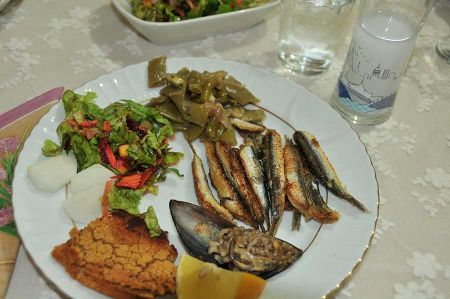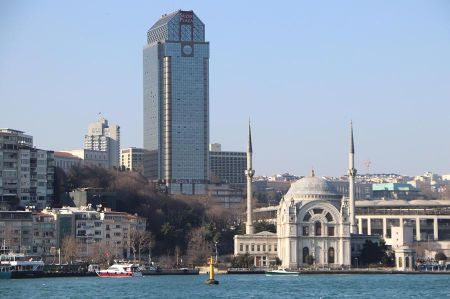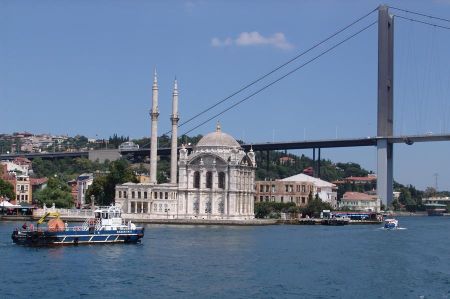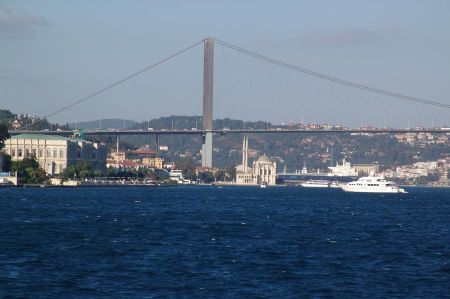Istanbul - Great City on the Bosporus
- Written by Portal Editor
Istanbul offers not just museums and famous historical and natural attractions. There is also an exciting nightlife and countless shopping opportunities, especially for silver, copper, and gold jewellery, and of course, carpets.
Istanbul offers not only museums and famous historical and natural attractions. There is also an exciting nightlife and countless shopping opportunities, especially for silver, copper, and gold jewellery, and of course, carpets.
Almost anything is possible in Istanbul. On the following pages, we'll give you some suggestions.
Istanbul - traditional Turkish food
 Big cities offer the best opportunity to get to know and sample the various variations of Turkish cuisine. Excellent, experienced, and traditional restaurants welcome you. A traditional Turkish meal with friends or family can last up to five hours. You'll be served a rich selection of different appetizers (meze), followed by a main course. In an open and friendly atmosphere, an informal conversation usually leads to the recounting of poems and stories about the good old days, while the national drink, raki, is often poured in large quantities. Always take your time when dining in a good restaurant.
Big cities offer the best opportunity to get to know and sample the various variations of Turkish cuisine. Excellent, experienced, and traditional restaurants welcome you. A traditional Turkish meal with friends or family can last up to five hours. You'll be served a rich selection of different appetizers (meze), followed by a main course. In an open and friendly atmosphere, an informal conversation usually leads to the recounting of poems and stories about the good old days, while the national drink, raki, is often poured in large quantities. Always take your time when dining in a good restaurant.
In its variety, flavour, and uniqueness, Turkish cuisine is comparable to French or Chinese cuisine.
Major Cities of the Ottoman Empire
 Major Turkish cities consist of the Old Town, modern districts, and the surrounding suburbs and settlements. Most visitors explore the Old Town in the centre, which is mainly divided into areas with specific crafts. There are districts for copper craftsmen, hat and shoe makers, tailors, spice and tool dealers, basket makers, and broom makers.
Major Turkish cities consist of the Old Town, modern districts, and the surrounding suburbs and settlements. Most visitors explore the Old Town in the centre, which is mainly divided into areas with specific crafts. There are districts for copper craftsmen, hat and shoe makers, tailors, spice and tool dealers, basket makers, and broom makers.
From Belgrade to Damascus, the major cities of the Ottoman Empire were divided into several districts for administrative purposes. Different groups – often ethnic or religious minorities – lived and worked in these districts. These districts were combined for local services such as the fire department, police, and municipal administration. In the centre of the Old Town, people gathered at the administrative buildings and religious meeting places to meet, discuss current affairs, or simply relax.
Churches, synagogues, mosques, and other educational institutions were built close together in the centres of the Old Towns. Today, modern city districts, with their skyscrapers and luxury shops, look the same all over the world. This is also the case in Turkey. However, the introduction of apartment blocks has brought about many major changes in the lives of the Turkish population. Some quite magnificent high-rise buildings, some with a patch of lawn in front, line the streets filled with a chaotic business world and equally traffic-filled ones.
Living and working in Istanbul
 The once close relationship between house and house has transformed into contact between apartment and apartment, or from floor to floor. The once small one- to three-story buildings with their surrounding gardens have given way to enormous skyscrapers, in which ten to fifteen families now live together—and Turkish families are huge! This has led to problems, such as the sharing of heating or repair costs, which can often cause problems even within the same family. Within three decades, a system of communal living had to be established with different laws, regulations, and administrative methods. This remains complicated even today. Life in these communities is frequently portrayed on Turkish television and in sketches. An old saying, truer than ever today, is: "Before you buy a new house, win over your neighbour."
The once close relationship between house and house has transformed into contact between apartment and apartment, or from floor to floor. The once small one- to three-story buildings with their surrounding gardens have given way to enormous skyscrapers, in which ten to fifteen families now live together—and Turkish families are huge! This has led to problems, such as the sharing of heating or repair costs, which can often cause problems even within the same family. Within three decades, a system of communal living had to be established with different laws, regulations, and administrative methods. This remains complicated even today. Life in these communities is frequently portrayed on Turkish television and in sketches. An old saying, truer than ever today, is: "Before you buy a new house, win over your neighbour."
But please don't make the mistake of assuming that chaos extends into the home.
Istanbul - high-rise buildings and village character
 Turkish homes are always immaculately tidy and clean (including teenagers' houses). In addition to the many retail shops on the ground floors of residential buildings, there is a weekly market in almost every neighbourhood. If you happen upon one while exploring the city, please take some time. Stroll through the "bazaar" and be amazed by the variety of offerings. After visiting a Turkish weekly market, every other one will seem like a boutique.
Turkish homes are always immaculately tidy and clean (including teenagers' houses). In addition to the many retail shops on the ground floors of residential buildings, there is a weekly market in almost every neighbourhood. If you happen upon one while exploring the city, please take some time. Stroll through the "bazaar" and be amazed by the variety of offerings. After visiting a Turkish weekly market, every other one will seem like a boutique.
The population living on the outskirts of the city, in the "overnight houses" (also called "village towns"), amounts to approximately 60% of the total urban population. The people who live here moved from the countryside to the city in the hope of improving their living conditions.
However, these settlements should by no means be compared to the slums in America or the barrios in South Africa; rather, they are ingenious ventures by people who sought to find housing in a country that, in the race to join the elite club of Western industrialized countries, has one of the highest urbanization rates in the world.
 This proliferation of construction has, of course, also caused serious problems. Countless riverbeds were simply built over, which ultimately led to flood disasters that anyone interested in Turkey will surely still remember. The residents are generally extended families, with each member usually pursuing some kind of occupation.
This proliferation of construction has, of course, also caused serious problems. Countless riverbeds were simply built over, which ultimately led to flood disasters that anyone interested in Turkey will surely still remember. The residents are generally extended families, with each member usually pursuing some kind of occupation.
Although some of the settlements are not fully connected to the municipal service network, almost all have electricity and the obligatory television antenna on the roof. They are not characterized by poverty and hopelessness, but rather by the desire for advancement. Let me conclude by stating that the Turkish city is far safer after dark than some others in the Western Hemisphere.
Our Trip to Istanbul – A Fascinating Encounter with History and the Present
 A trip to Istanbul is like stepping between two worlds – Europe and Asia, past and present. This unique metropolis on the Bosphorus combines oriental traditions with a Western lifestyle and captivates millions of travellers every year. Our trip to Istanbul was characterized by impressive architecture, delicious cuisine, and unforgettable moments.
A trip to Istanbul is like stepping between two worlds – Europe and Asia, past and present. This unique metropolis on the Bosphorus combines oriental traditions with a Western lifestyle and captivates millions of travellers every year. Our trip to Istanbul was characterized by impressive architecture, delicious cuisine, and unforgettable moments.
First Impression – Welcome to the City of Cultures
Immediately upon arrival, you can feel the vibrancy of Istanbul. Whether at bustling Taksim Square, along the historic Istiklal Street, or at the sight of the majestic Blue Mosque – Istanbul captivates with its diversity and energy. The sounds of the city, the scent of spices and fresh simit (sesame pastries), and the vibrant hustle and bustle create a unique atmosphere.
Highlights of our Istanbul trip
1. Historic Istanbul: Sultanahmet
 The Sultanahmet district is the heart of the ancient city. The world-famous Hagia Sophia, the Blue Mosque, and Topkapi Palace are located there. The historic atmosphere of these places allows you to experience the splendour of the Ottoman Empire up close.
The Sultanahmet district is the heart of the ancient city. The world-famous Hagia Sophia, the Blue Mosque, and Topkapi Palace are located there. The historic atmosphere of these places allows you to experience the splendour of the Ottoman Empire up close.
2. The Grand Bazaar – A Paradise for Explorers
In the Grand Bazaar (Kapalı Çarşı), you can spend hours strolling through the winding alleys, haggling, and marvelling. Carpets, gold jewellery, ceramics, spices – everything your heart desires. A feast for the senses!
3. Bosphorus Cruise – Between Two Continents
 A boat trip on the Bosphorus was one of our highlights. Passing magnificent palaces and historic fortresses, we experienced the unique transition between Europe and Asia.
A boat trip on the Bosphorus was one of our highlights. Passing magnificent palaces and historic fortresses, we experienced the unique transition between Europe and Asia.
4. Modern Contrasts in Karaköy and Galata
Modern life pulsates in Karaköy and around the Galata Tower. Here you'll find hip cafés, art galleries, and street art – an urban contrast to the historic sites.
Culinary Delights – The Diversity of Turkish Cuisine
We were completely captivated by Turkish cuisine. From classic kebabs to fresh meze, sweet baklava, and the famous Turkish tea and mocha – Istanbul is a paradise for gourmets. We especially recommend restaurants with a view of the Bosphorus at sunset.
Please read as well:
Grand Rue de Pera - Istiklal Street Istanbul
Princes’ Islands of Marmara Sea by sailing boat
